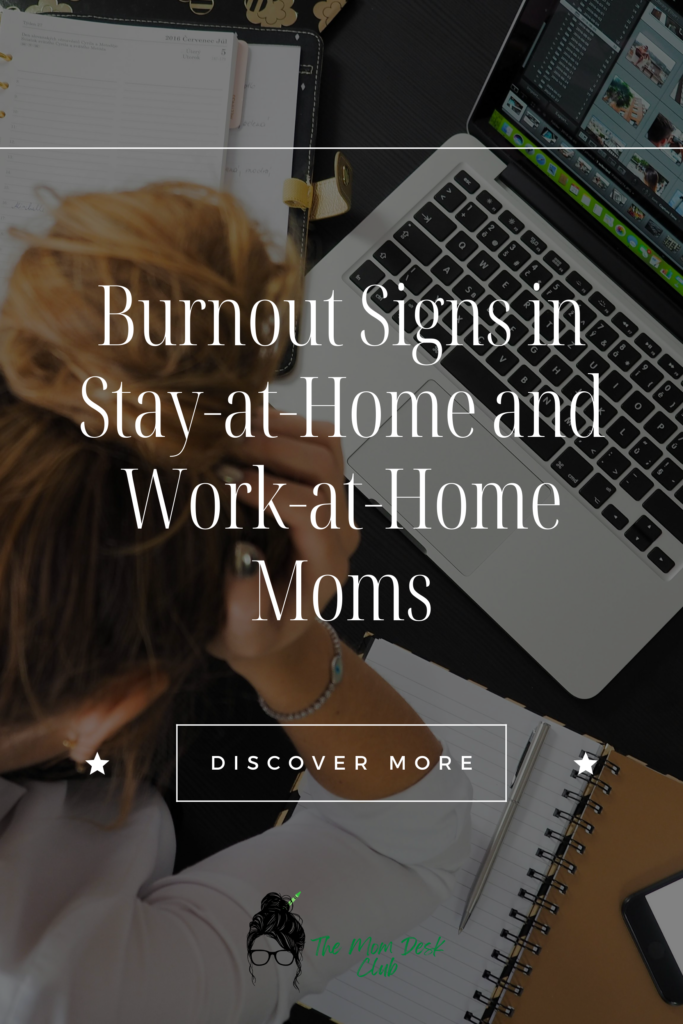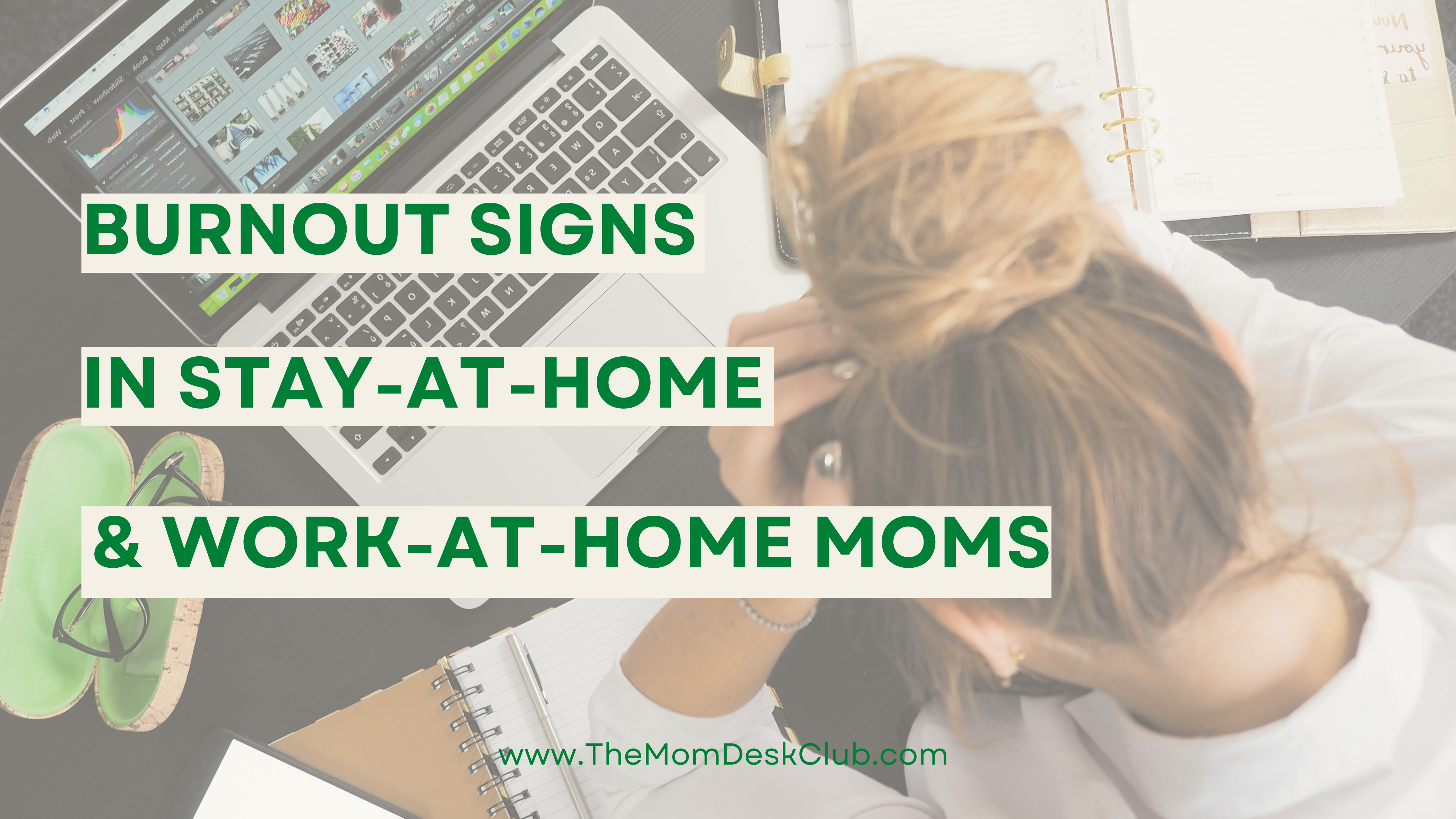Burnout Signs in Stay-at-Home and Work-at-Home Moms
Stay-at-home moms and work at home moms are the unsung heroes who gracefully navigate the intricate dance of raising a family while maintaining a household, and then a career as well. Yet, beneath the surface of this seemingly idyllic lifestyle, there exists a silent struggle that often goes unnoticed: stay-at-home mom burnout.
The signs of “mommy burnout” in these dedicated women can be subtle yet impactful, affecting not only their own well-being but also the harmony of the family unit. As we delve into the realm of stay-at-home mom burnout signs, it becomes evident that acknowledging and addressing these indicators is essential for fostering a healthier and more sustainable caregiving environment. Moreover, in the evolving landscape of remote work, the challenges extend beyond traditional roles, encompassing work-at-home moms who grapple with a unique set of stressors.
This blog aims to unravel the nuanced symptoms of mom burnout in both stay-at-home and work-at-home moms, offering insights and strategies to support these incredible women in their demanding yet fulfilling journeys.

10 Signs of Burnout to Be Aware Of
As women continue to play multifaceted roles in both professional and personal spheres, the risk of burnout becomes a prevalent concern. Recognizing the signs of burnout is crucial for maintaining mental and physical well-being. Here are some top signs that women who experience burnout report:
- Chronic Exhaustion: Persistent fatigue that transcends ordinary tiredness and hampers daily functioning is a key indicator of burnout. Women may find themselves feeling drained, which manifests as physical and emotional exhaustion.
- Loss of Interest: A decline in enthusiasm for activities that once brought joy and fulfillment can signal burnout. Hobbies, socializing, and even work may become mundane or overwhelming.
- Decreased Performance: Burnout can lead to a decline in professional or academic performance. Women may struggle to meet deadlines, make decisions, or maintain the same level of productivity.
- Increased Irritability: Heightened levels of irritability and impatience, whether at work or home, may be indicative of burnout. Small stressors can trigger disproportionate emotional responses.
- Sleep Disturbances: Burnout often disrupts sleep patterns, leading to difficulties falling asleep, staying asleep, or experiencing restful sleep. Insomnia becomes a common companion for those grappling with burnout.
- Physical Symptoms: Chronic headaches, muscle pain, and gastrointestinal issues may manifest as physical symptoms of burnout. The mind-body connection plays a significant role in overall well-being.
- Cynicism and Detachment: A sense of detachment and cynicism towards work, relationships, or daily life in general can emerge. Women may find it challenging to connect emotionally with others or to derive meaning from their endeavors.
- Neglecting Self-Care: Burnout often results in neglecting self-care routines. Women may abandon healthy habits, such as exercise, proper nutrition, and relaxation practices, exacerbating the cycle of burnout.
- Impaired Concentration: Difficulty concentrating and making decisions are cognitive manifestations of burnout. Women may experience mental fog, forgetfulness, and a sense of being overwhelmed by even simple tasks.
- Isolation: Burnout can lead to social withdrawal and a desire for solitude. Women may retreat from social interactions, further amplifying feelings of loneliness and stress.
Recognizing these signs is the first step towards addressing and mitigating burnout. It’s essential for women to prioritize self-care, set boundaries, and seek support to navigate the challenges and pressures they face in their diverse roles.
Long-Term Consequences of Burnout
Long-term, unchecked burnout can have profound consequences that extend beyond immediate feelings of fatigue or stress. The cumulative impact on physical, mental, and emotional well-being can be severe. Here are some significant consequences of long-term, unchecked burnout:
- Physical Health Issues: Prolonged burnout is associated with an increased risk of various physical health problems. Chronic conditions such as cardiovascular diseases, hypertension, and gastrointestinal disorders can arise or worsen due to the prolonged stress response.
- Mental Health Disorders: Persistent burnout can contribute to the development or exacerbation of mental health disorders, including depression, postpartum depression, anxiety, and chronic fatigue syndrome. The constant strain on the mind can lead to a decline in overall psychological well-being.
- Impaired Immune System: Chronic stress associated with long-term parental burnout weakens the immune system, making individuals more susceptible to illnesses and infections. The body’s ability to fight off diseases may be compromised.
- Cognitive Decline: Prolonged exposure to stress hormones can negatively impact cognitive function. Long-term burnout may contribute to memory problems, difficulty concentrating, and impaired decision-making abilities.
- Increased Risk of Burnout Relapse: Without intervention and adequate recovery, individuals who have experienced burnout may be more susceptible to relapse. Resuming normal activities without addressing the root causes can perpetuate the cycle of burnout.
- Strained Relationships: Burnout can strain relationships, both personally and professionally. The emotional, physical, and mental exhaustion experienced by individuals may lead to increased conflicts, reduced communication, and a sense of isolation from others.
- Decreased Job Performance: In the workplace, long-term burnout can significantly impact job performance. Reduced productivity, increased absenteeism, and a lack of motivation are common consequences. This can have professional repercussions, affecting career advancement and job satisfaction. Job burnout is a real experience, but the good news is that you can still protect and guard yourself from those stressful situations.
- Negative Impact on Personal Goals: Burnout may hinder individuals from pursuing and achieving personal goals. The lack of energy, motivation, and focus can impede progress in various areas of life, leading to unfulfilled aspirations.
- Sleep Disorders: Chronic stress and burnout often disrupt sleep patterns. Insomnia, frequent awakenings, and restless sleep can contribute to a cycle of fatigue and exacerbate overall health issues. When you aren’t getting enough sleep, burnout is sure to be just around the corner.
- Financial Consequences: The impact of burnout extends beyond personal well-being and can have financial repercussions. Reduced productivity at work, increased healthcare costs, and potential job loss can contribute to financial stress.
Recognizing the consequences of long-term burnout underscores the importance of preventive measures and creating a support system. Addressing burnout early on, implementing self-care strategies, and seeking professional help when needed can contribute to recovery and overall well-being.

Creative Ways A Work at Home Mom and Stay at Home Mom Can Combat Burnout
Combatting burnout is crucial for the well-being of work-at-home moms who often juggle multiple responsibilities. Here are some effective ways women can combat burnout in their roles as work-at-home moms:
- Establish Clear Boundaries: Set clear boundaries between work and personal life. Designate specific work hours and stick to them to prevent work from encroaching on personal time. Communicate these boundaries with family members to ensure understanding and support.
- Prioritize Self-Care: Make self-care a non-negotiable part of the routine. Whether it’s a few minutes of meditation, a brisk walk, or indulging in a hobby, taking much time for oneself is essential for recharging and maintaining mental well-being.
- Create a Dedicated Workspace: Designate a dedicated workspace within the home. Having a defined area for work helps create a psychological boundary and allows for better focus during work hours.
- Delegate Responsibilities: Recognize that it’s okay to seek help and delegate tasks. Share household responsibilities with a family member or consider hiring assistance for tasks that can be outsourced, allowing more time for work and self-care.
- Time Management: Efficient time management is key. Prioritize tasks, set realistic goals, and break them down into manageable chunks. This approach helps prevent feeling overwhelmed by a long to-do list.
- Take Breaks: Incorporate regular breaks into the workday. Short breaks, even if just for a few minutes, can enhance productivity and reduce stress levels. Use this time to stretch, take a breath of fresh air, or engage in a quick relaxation exercise.
- Stay Connected: Combat isolation by staying connected with friends, mom friends, family, and other work-at-home moms. Social support is vital for emotional well-being. Schedule regular virtual or in-person meet-ups to maintain a sense of community.
- Learn to Say No: Recognize your limits and be willing to say no to additional responsibilities when necessary. Overcommitting can lead to burnout, so it’s important to be selective about the tasks and projects undertaken.
- Practice Mindfulness: Incorporate mindfulness practices into the daily routine. Techniques such as meditation, deep breathing, or mindfulness exercises can help manage stress and promote a sense of calm.
- Seek Professional Support: At the end of the day, if burnout persists, consider seeking professional support. A counselor or therapist can provide guidance and coping strategies to manage stress and prevent burnout.
- Celebrate Achievements: Acknowledge and celebrate achievements, both big and small. Recognizing accomplishments, no matter how minor, contributes to a positive mindset and reinforces a sense of accomplishment.
Remember, combating burnout is an ongoing process that requires self-awareness and a commitment to self-care. In the long run, by implementing these strategies, work-at-home moms can create a healthier balance between their personal and professional lives and avoid the burnout state.

It’s About Thriving Not Just Surviving
In the whirlwind of responsibilities that stay-at-home and work-at-home moms navigate, burnout can cast a long shadow over their well-being. As we conclude this exploration into the signs of mom burnout for these incredible women, it’s crucial to emphasize the importance of self-compassion. Recognizing that burnout is not a sign of weakness but a signal to reassess and prioritize one’s own needs is the first step toward healing.
In the journey to combat burnout, let us champion a culture that values the multifaceted roles of stay-at-home and a working mom. Encouraging open conversations, providing support networks, and validating the challenges these women face fosters an environment where seeking help is not only accepted but celebrated. Together, we can redefine success for moms—measuring it not just by productivity but by sustainable happiness and well-balanced lives.
As we close this chapter on burnout, let it serve as a reminder that the well-being of stay-at-home and work-at-home moms is a collective responsibility. By acknowledging their efforts, understanding the signs of burnout, and actively participating in creating supportive communities, we contribute to a world where these remarkable women can thrive in their vital roles while maintaining their own physical, mental, and emotional health.
Pin This for Later!


